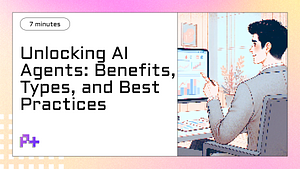Summary
- 1. Understanding AI Chatbots: What They Are and How They Work
- 2. How to Choose the Best AI Chatbot for Your Needs
- 3. Top AI Chatbots for 2025: A Comprehensive Comparison
- 4. Pricing and Plans: How Much Does It Cost to Use an AI Chatbot?
- 5. Tips for Maximizing Productivity with AI Chatbots and Automation Tools
1. Understanding AI Chatbots: What They Are and How They Work
AI chatbots are advanced software applications designed to simulate human conversation through artificial intelligence. They can interact with users via text or voice, providing assistance, answering questions, and even performing tasks. The core technology behind AI chatbots includes natural language processing (NLP) and machine learning (ML), which enable these bots to understand and respond to user inquiries in a human-like manner. By analyzing user input, AI chatbots can recognize intent and context, allowing them to deliver relevant and accurate responses.
The functionality of AI chatbots can vary widely, depending on their design and purpose. Some chatbots are rule-based, operating on predefined scripts and responses, while more sophisticated AI chatbots utilize machine learning algorithms to learn from interactions and improve over time. This adaptability allows them to handle a broader range of queries and provide more personalized experiences. For instance, customer service chatbots can assist users with troubleshooting, order tracking, and FAQs, making them invaluable tools for businesses seeking to enhance customer engagement and streamline operations.
Incorporating AI chatbots into various platforms, such as websites, messaging apps, and social media, has revolutionized how businesses interact with their customers. As user expectations for instant responses and 24/7 availability continue to rise, AI chatbots have emerged as essential tools for enhancing customer support and satisfaction. From simplifying booking processes to providing product recommendations, these intelligent systems not only enhance user experience but also free up human resources to focus on more complex tasks. Understanding AI chatbots is crucial for businesses looking to leverage technology for improved communication and operational efficiency.
2. How to Choose the Best AI Chatbot for Your Needs
Selecting the right AI chatbot for your business or personal needs can significantly enhance user engagement and streamline communication. To begin, it's essential to define your specific requirements. Consider factors such as the primary purpose of the chatbot—whether it's for customer support, lead generation, or to provide information. Understanding your objectives will help narrow down options and ensure you choose a solution that aligns with your goals. Additionally, evaluate the complexity of the interactions you expect. Some AI chatbots are designed for simple FAQs, while others can handle more complex conversations and integrate with existing systems.
Another critical factor in choosing the best AI chatbot is the platform compatibility and ease of integration. Assess whether the chatbot can seamlessly integrate with your website, social media platforms, or other tools you currently use, like CRM systems. Many modern AI chatbots offer integrations with popular messaging apps, which can be a game-changer for businesses looking to reach customers where they already communicate. Furthermore, consider the scalability of the chatbot. As your business grows, you may require more advanced features or the ability to handle increased traffic. Opting for a chatbot solution that can grow with you is crucial for long-term success.
Finally, don't overlook the importance of user experience and customization options. A good AI chatbot should not only be effective but also user-friendly. Look for chatbots that offer customizable templates or allow you to design conversational flows that reflect your brand’s voice and tone. Additionally, investigate the analytics capabilities of the chatbot. Robust reporting features can provide insights into user interactions, helping you refine your approach over time. By considering these factors—specific needs, integration capabilities, and user experience—you can make an informed decision and choose the best AI chatbot that meets your unique requirements.
3. Top AI Chatbots for 2025: A Comprehensive Comparison
As we look towards 2025, the landscape of AI chatbots is evolving rapidly, driven by advancements in machine learning, natural language processing, and user experience design. Among the leading contenders in this space are ChatGPT, Google's Bard, and Microsoft's Copilot. Each of these AI chatbots brings unique features and capabilities that cater to different user needs, making them suitable for a variety of applications, from customer service to personal assistance.
ChatGPT, developed by OpenAI, remains a popular choice due to its conversational abilities and contextual understanding. It excels in providing detailed responses and engaging in dynamic dialogues, making it ideal for users seeking an interactive experience. With continuous updates, ChatGPT has improved its capacity to handle complex queries and learn from user interactions, positioning itself as a versatile tool for both businesses and individual users. Its API integration allows seamless implementation in various platforms, enhancing its usability across different sectors.
On the other hand, Google's Bard leverages the power of its extensive search capabilities to deliver real-time information and answers. This AI chatbot stands out for its ability to pull data from the web, ensuring users receive up-to-date responses. This feature is particularly beneficial for industries where information is constantly changing, such as finance and technology. Similarly, Microsoft's Copilot, integrated with Office applications, focuses on augmenting productivity. It assists users in drafting emails, summarizing documents, and generating creative content, making it a valuable asset for professionals looking to enhance their workflow. As we approach 2025, these top AI chatbots will continue to shape how we interact with technology, providing efficient solutions tailored to our evolving needs.
4. Pricing and Plans: How Much Does It Cost to Use an AI Chatbot?
When considering the implementation of an AI chatbot, one of the foremost questions that arises is the cost associated with its use. Pricing for AI chatbots can vary significantly based on several factors, including the complexity of the technology, the features offered, and the scale of deployment. Typically, businesses can choose from various pricing models, such as subscription-based, pay-as-you-go, or one-time licensing fees. Subscription plans often range from as low as $15 per month for basic functionality to upwards of $500 per month for advanced features and greater customization options. This flexibility allows businesses of all sizes to find a plan that fits their budget while still leveraging the power of AI.
In addition to the basic subscription costs, organizations should also consider any additional expenses that might come into play. These can include setup fees, maintenance charges, and costs for ongoing training and updates to ensure the AI chatbot remains effective and current with industry trends. For instance, companies looking for custom integrations with existing software systems may incur higher costs. It’s also important to note that while some platforms offer free trials, they often come with limitations that may not provide a complete picture of the chatbot's capabilities. Therefore, businesses should carefully assess their specific needs to determine the total cost of ownership for the AI chatbot they are considering.
Ultimately, the investment in an AI chatbot can lead to significant returns if implemented correctly. Increased efficiency, enhanced customer service, and improved engagement are just a few of the benefits that can offset the initial costs. When evaluating pricing and plans, businesses should also consider potential savings from reduced human resource costs and the ability to operate 24/7. By weighing these factors against the pricing structures available, organizations can make informed decisions that align with their financial goals while enhancing their customer interaction strategies through AI technology.
5. Tips for Maximizing Productivity with AI Chatbots and Automation Tools
To maximize productivity with AI chatbots and automation tools, it’s essential to first identify the specific tasks these technologies can streamline within your workflow. AI chatbots can handle a variety of functions, such as customer support, scheduling, and data collection. By automating these repetitive tasks, businesses can free up valuable time for employees to focus on more strategic initiatives. For instance, implementing a chatbot on your website can significantly reduce response times for customer inquiries, allowing your support team to concentrate on complex issues that require human intervention.
Next, consider integrating your AI chatbot with other automation tools to enhance its capabilities. Many chatbots can seamlessly connect with customer relationship management (CRM) systems, email marketing platforms, and project management software. This integration allows for a more cohesive flow of information, enabling your chatbot to provide personalized responses based on customer data or project updates. By leveraging these connections, businesses can ensure that their AI chatbots not only serve immediate queries but also support broader organizational goals, leading to improved efficiency and a more satisfying user experience.
Lastly, continuous monitoring and optimization of your AI chatbot is vital for maintaining productivity gains. Utilize analytics to assess user interactions and identify areas for improvement. Regularly update the chatbot’s knowledge base and scripts to ensure it stays relevant and effective. Gathering feedback from users can also provide insights into how the chatbot can better meet their needs. By being proactive in optimizing your AI chatbot and automation tools, you can create a robust system that not only enhances productivity but also drives engagement and satisfaction among your customers.



